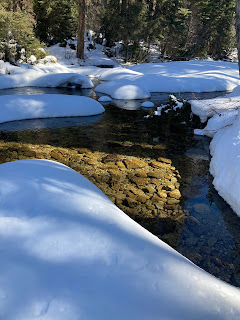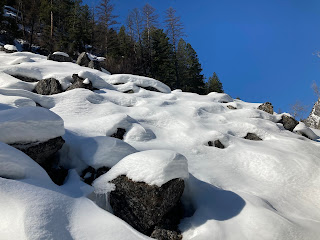On a sunny winter’s day at McCauley Butte next to the Bitterroot River, I met with staff from the Watershed Education Network (WEN) and students and their educators from Aspire High School. Aspire is an “alternative” school based on experiential education and recently acquired a good portion of land on McCauley Butte and the Flat. Our group was assembled to council with Aspire students as they investigated a community resilience topic for the RISE Challenge Big Sky, hosted by Brightways Learning and WEN. The students were confronted with identifying a real-world environmental issue and developing a solution with an action plan to address this issue. These students chose to address how to use a riparian floodplain as a year-round outdoor classroom.
I first learned about their project when Deb Fassnacht from WEN contacted the Missoula Conservation District (CD) to ask if we had any insight on what sort of structures could be constructed in the floodplain, and if a representative from the CD could come out and meet with the students. I was happy to oblige.
The land Aspire school owns is the riparian area between the Butte and the Bitterroot River. The riparian area is beautiful from an ecological standpoint, and I would consider it high-value habitat. The area has beaver ponds and cottonwoods and hosts waterfowl, woodpeckers, and other wildlife. The challenge for the students is this land is not only in the floodplain, but the floodway. The floodway doesn’t just get standing water covering it occasionally; flood water moves through these areas with a fair bit of velocity, like you-better-watch-out-for-ponderosa-pines-floating-through kind of velocity. Almost all planning and zoning regulations prohibit any development in the floodway.
The students knew they could not build a traditional structure or even a boardwalk in this area, so they were coming up with all sorts of ideas on how to create an attractive educational space on the property. As I covered some of the regulatory challenges the students faced, including a conservation easement that the previous owners put in place with the Five Valleys Land Trust, the students began discussing (more alternatives?) ideas. Their eyes lit up as they discussed solutions such as rope bridges, floating decks, and hanging platforms. While I could speak about zoning, floodplain regulation, and conservation easements generally, the Missoula Conservation District only has regulatory authority over 310 permits based on Montana’s Natural Streambed and land Preservation Act.
A 310 permit is required to ensure that natural rivers and streams, and the lands and property immediately adjacent to them, are protected and preserved to be available in their natural or existing state. The interesting thing about this particular permit is that there is no automatic definable jurisdictional boundary. Often time the CD generally looks at the riparian buffer within 50 feet of a major navigable river, but any project that degrades environmental life support systems or causes unreasonable depletion and degradation of natural resources in a riparian corridor could come under 310 jurisdiction, and yet… almost no one knows a 310 permit application is needed for work near a river.
After talking 310 permitting and wandering the land, we headed back to our vehicles. I think I left the students with more questions than answers. I felt bad about that, but that is the nature of science and exploration. It was awesome to see students engaged in place-based education and the excitement of the students as they stood on a frozen beaver pond and talking about beaver ecology will stay with me for a long time.
Radley and a student investigate a possible beaver breathing
hole in the ice. (Photo by Cassie Sevigny)
What will these students propose to do to make this floodplain a year-round classroom? Will they try to suspend fellow classmates from the trees? Will they float them over a beaver pond? I don’t know, but in any case, they are going to learn a lot about rivers, flood plains, and riparian areas, and how humans interact in these changing riverine environments.
-Radley Watkins
Resource Conservationist
Missoula Conservation District







